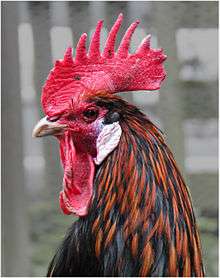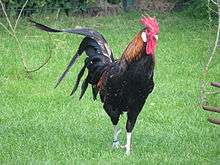Bergische Kräher
 | |
| Conservation status | GEH: I, extremely endangered |
|---|---|
| Country of origin | Germany |
| Traits | |
| Weight | Male: 3–3.5 kg[1] |
| Female: 2–2.5 kg[1] | |
| Egg color | white |
| Comb type | single |
| Classification | |
| PCGB | rare long crowers[2] |
|
Chicken Gallus gallus domesticus | |
The Bergische Kräher is a German breed of domestic chicken from the Bergisches Land, in the state of North Rhine-Westphalia in western Germany.[1][3] It is named for its unusually long crow, up to five times as long as that of other breeds, and belongs to the group of long-crowing chicken breeds, which are found from south-east Europe to the Far East.[4]
History


The Bergische Kräher has been bred in the Bergisches Land for hundreds of years, and there are various myths about its origins.[5] It was probably brought there from south-east Europe or the Middle East at the time of the Crusades, and may have been spread through the area by Cistercian monks.[4] It is closely related to the Bergische Schlotterkamm[6]:14[7]:134. Crowing contests were held for the birds, and they were selectively bred for their crowing ability.[4] A breed association, the Kräherzüchtervereinigung, was founded in 1884,[6] and the first breed standard dates from 1885.[8]:333
Today the Bergische Kräher is a rare breed. In 2001 it was an "endangered breed of the year" of the Gesellschaft zur Erhaltung alter und gefährdeter Haustierrassen,[9] and is listed in category I, "extremely endangered", on the red list of that organisation.[10] In 2009, 77 cocks and 337 hens were recorded;[11] in 2013 the total population was 329.[3]
Characteristics
Only the black-brown-golden colour is considered in international standards, which is called "gold" in the British Standard[12]. Hen birds are black with some gold markings on the wings and breast; cocks have gold neck-hackles and maroon markings on the wings. The black colour variety is extinct, black-silver coloured animals are extremely rare[6]. Like the Bergische Schlotterkamm, the Bergische Kräher shows typical broad lacing ("Dobbelung") of the breast feathers.[5] Cocks weigh 3–3.5 kg and hens 2–2.5 kg. The comb is single, the earlobes are white, and the legs are slate-blue.[5][8]:333 The Bergische Kräher is a dual-purpose breed, with good meat qualities. Hens lay 120–150 white eggs per year, of up to 60 g in weight; they have little tendency to broodiness.
Cock crowing contests
Cock crowing contests with Bergische Krähers have been a sport in the Bergische Land for centuries[13]. Since 1923, the Breed Association has been organising crowing contests on a yearly basis on Ascension Thursday[6]. Contrary to most traditional cock crowing contests in Germany, the Netherlands and Belgium, length and beauty of the crowing are rated here, not the crowing frequentness[14].
-

A kräher used in the Coat of Arms of Haan
-

Hen
-
.jpg)
Historical Illustration, Jean Bungartz, 1885
-

Young cock at a crowing competition, 2015
-
One day old chick
References
- 1 2 3 Rassetafeln: Bergische Kräher (in German). Bund Deutscher Rassegeflügelzüchter. Accessed August 2014.
- ↑ Breed Classification. Poultry Club of Great Britain. Accessed August 2014.
- 1 2 Breed data sheet: Bergische Kräher/Germany. Domestic Animal Diversity Information System of the Food and Agriculture Organization of the United Nations. Accessed August 2014.
- 1 2 3 Bergische Kräher (in German). Gesellschaft zur Erhaltung alter und gefährdeter Haustierrassen. Accessed August 2014.
- 1 2 3 Schwerpunkt - Geflügel: Bergische Kräher (in German). Gesellschaft zur Erhaltung alter und gefährdeter Haustierrassen. Accessed August 2014.
- 1 2 3 4 Armin Six (2015). Bergische Kräher (in German). Gesellschaft zur Erhaltung alter und gefährdeter Haustierrassen. Accessed October 2015.
- ↑ Edward Brown (1906). Races of Domestic Poultry. London: Edward Arnold
- 1 2 Victoria Roberts (2008). British poultry standards: complete specifications and judging points of all standardized breeds and varieties of poultry as compiled by the specialist breed clubs and recognised by the Poultry Club of Great Britain. Oxford: Blackwell. ISBN 9781405156424.
- ↑ Die gefährdete Nutztierrasse des Jahres 2001 (in German). Gesellschaft zur Erhaltung alter und gefährdeter Haustierrassen. Accessed August 2014.
- ↑ Gemeinsame Liste alter und einheimischer Geflügelrassen in Deutschland der GEH und des BDRG (in German). Gesellschaft zur Erhaltung alter und gefährdeter Haustierrassen. Accessed August 2014.
- ↑ Rote Liste: Einheimische Nutztierrassen in Deutschland 2013 (in German). Bundesanstalt für Landwirtschaft und Ernährung. Accessed August 2014.
- ↑ "Archived copy". Archived from the original on 26 September 2015. Retrieved 2015-10-31. List of European Poultry Standards, by the Entente Européenne. Retrieved October 2015
- ↑ Friedrich Wieden: Die Geschichte der Bergischen Kräher. Deutscher Geflügelhof 43. Oldenburg 1949.
- ↑ Cock crowing contest recognised as National Heritage in Belgium Stefaan De Groote, Het Nieuwsblad, 27. June 2011 (in Dutch). Accessed October 2015